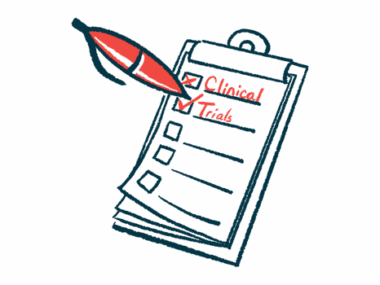Researching New Therapies: Can We Learn to Set Broken ‘Brain Bones’?
Written by |

When my son was diagnosed with Angelman syndrome 20 years ago, I believed that we would find a cure. Lou had severe developmental delays and epilepsy. In 2000, the genetic cause of those symptoms was considered an address, not a route to treatment. Few people realized that his diagnosis was the clue, the key to repairing his faulty wiring.
When Lou was 2, we attended his first individualized education program meeting where I requested teaching techniques tailored to Angelman syndrome. His preschool teacher told us, “We don’t care what his genetic diagnosis is, and neither should you. You just need to get used to the idea that he is mentally retarded. We teach all kids with mental retardation the same way.”
The term “mental retardation” was not as jarring back then as it is now. But the message that Lou’s diagnosis didn’t matter persisted for almost two decades.
The difference between compassion and acceptance
Lou struggled to learn his colors and shapes at preschool, and I struggled to learn about molecular biology and developmental psychology. I wanted to help him, and eventually I consulted experts in the field. Most of them responded with a similar message: “Why not accept your son the way he is?” They saw my son’s genetic injury as part of his identity.
Over the years, the term “mental retardation” fell into disregard. As autism has become more commonplace, society has begun to welcome all forms of diversity, including neurodiversity. Acceptance of differences and compassion for those in need are qualities of a wise person and an evolved civilization.
But compassion does not mean complacency. Acknowledging the worth and dignity of an impoverished person does not mean accepting poverty as a permanent condition. Having compassion for an injured person does not mean accepting the injury.
If someone breaks their leg, a doctor sets the bone. Casts, crutches, and wheelchairs help the injured get around until they heal. We don’t leave the bone broken and encourage acceptance of “osteodiversity.” But when it comes to neurological injuries, people confuse the brain, identity, and soul. My son’s injury is considered part of him — part of his personality, part of who he is.
Setting the broken ‘brain bone’
But with new advances in treatments, we might be able to heal this type of injury. Three upcoming clinical trials were announced at the FAST Science Summit, hosted in Chicago by the Foundation for Angelman Syndrome Therapeutics last December.
Enrollment in a Phase 1/2 clinical trial for an antisense oligonucleotide treatment for Angelman syndrome being developed by GeneTx Biotherapeutics and Ultragenyx Pharmaceutical is due to begin in the first half of 2020.
Two other clinical trials of antisense oligonucleotides also are planned to start in 2020 — one sponsored by Roche/Genentech, and the other by Biogen and Ionis Pharmaceuticals.
Other pharmaceutical companies, including Sarepta Therapeutics and StrideBio, are collaborating on the development of gene-based therapies for treating Angelman syndrome and other central nervous system and neuromuscular disorders. Things are beginning to change for genetic brain disorders.
Treatments have eased the effects of Lou’s original genetic injury for 20 years. But now, finally, we may be able to set his broken “brain bone.”
He will still need all kinds of neurological crutches and therapies and wheelchair ramps while his injury heals. Furthermore, the bone may never heal completely, or it may be permanently bent. But the gap in my son’s 15th chromosome, just like a break in a femur, may eventually regrow.
It turns out that the underlying genetic cause of Angelman syndrome wasn’t just an address in the DNA; it was a therapeutic recipe for healing, a combination for the molecular lock.
Continuing progress
Recently, we have been identifying the genetic sources of many neurodevelopmental disorders and picking an increasing number of DNA locks. We need to accept and have compassion for neurodiverse people, just as we need to build accommodations, such as cognitive ramps. But we may no longer need to accept cognitive disability as a permanent condition.
I believe that this year, 2020, could be the watershed moment.
Go science! Go brains!
***
Note: Angelman Syndrome News is strictly a news and information website about the disease. It does not provide medical advice, diagnosis, or treatment. This content is not intended to be a substitute for professional medical advice, diagnosis, or treatment. Always seek the advice of your physician or other qualified health provider with any questions you may have regarding a medical condition. Never disregard professional medical advice or delay in seeking it because of something you have read on this website. The opinions expressed in this column are not those of Angelman Syndrome News, or its parent company, Bionews Services, and are intended to spark discussion about issues pertaining to Angelman syndrome.






undeadmerc3
While I disagree with the concept of Nero diversity, I will give this article credit for at least showing me some sympathy given the struggles I go through. I still want there to be a cure and given how fickle technology is, it's inevitable.
Vanessa
I really enjoyed your article. It renews my hope in a cure for AS. However, something that has become increasingly apparent to me is all the talk about turning on the UBE3A in the father’s 15 chromosome or repairing the damages in the mother’s contributed 15 chromosome. A cure is on the horizon in relation to those individuals with AS from a deletion, imprinting defect, etc. but, how does this impact the individuals with AS by way of UPD? Are those individuals further away from a cure as they are completely lacking the 15th from the mother? My son is UPD. Where could I find the research for a cure pertaining to that genotype?
Terry Jo Bichell
The UPD genotype may actually benefit most from some of these treatments because the goal is to activate the paternal gene. With UPD, there are two paternal copies, so there is even more chance that the gene can be activated. The first trials will probably need to establish how closely the dosage can be controlled, to make sure that there isn't overactivation, but once that is established, these treatments will likely benefit all genotypes. Also, the non-genetic treatments, such as OV101 may benefit all genotypes. These treatments are not just for patients with deletions.